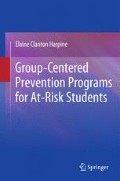Abstract
Self-efficacy is the internal control mechanism (confidence and intrinsic desire) that allows students to succeed academically and achieve psychological well-being and happiness (Taylor et al. 2000). Children must have positive self-efficacy if they are to learn, but simply distorting grading scales under the disguise of preserving self-esteem will not help students learn (Baumeister et al. 2005). Self-esteem and self-efficacy are not the same, and it is self-efficacy, not self-esteem, that helps students learn (Bandura 1977; Clanton Harpine 2008).
Access this chapter
Tax calculation will be finalised at checkout
Purchases are for personal use only
References
Bandura, A. (1977). Self-efficacy: Toward a unifying theory of behavior change. Psychological Review, 84, 191–215.
Bandura, A. (1995). Exercise of personal and collective efficacy in changing societies. In A. Bandura (Ed.), Self-efficacy in changing societies (pp. 1–45). New York: Cambridge University Press.
Bandura, A. (1997). Self-efficacy: The exercise of control. New York: W. H. Freeman.
Bandura, A., Barbaranelli, C., Vittorio Caprara, G., & Pastorelli, C. (2001). Self-efficacy beliefs as shapers of children’s aspirations and career trajectories. Child Development, 72, 187–206.
Baumeister, R. F., Campbell, J. D., Krueger, J. I., & Vohs, K. D. (2005). Exploding the self-esteem myth. Scientific American, 292, 84–92.
Brigman, G., & Webb, L. (2007). Student success skills: Impacting achievement through large and small group work. Group Dynamics: Theory, Research, and Practice, 11, 283–292. doi: 10.1037/1089-2699.11.4.283
Buhs, E. S., Ladd, G. W., & Herald, S. (2006). Peer exclusion and victimization: Processes that mediate the relation between peer group rejection and children’s classroom engagement and achievement? Journal of Educational Psychology, 98, 1–13. doi: 10.1037/0022-0663.98.1.1
Catalano, R. F., Mazza, J. J., Harachi, T. W., Abbott, R. D., Haggerty, K. P., & Fleming, C. B. (2003). Raising healthy children through enhancing social development in elementary school: Results after 1.5 years. Journal of School Psychology, 41, 143–164.
Clanton Harpine, E. (2007a, August). A community-based after-school prevention program: A one year review of the Camp Sharigan program. Paper presented at the annual convention of the American Psychological Association, San Francisco, CA.
Clanton Harpine, E. (2008). Group interventions in schools: Promoting mental health for at-risk children and youth. New York: Springer.
Clanton Harpine, E. (2010a). Erasing failure in the classroom (Camp Sharigan, a ready-to-use group-centered intervention for grades 1-3 2nd ed., Vol. 1). Aiken, SC: Group-Centered Learning.
Clanton Harpine, E., & Reid, T. (2009a). Enhancing academic achievement in a Hispanic immigrant community: The role of reading in academic failure and mental health. School Mental Health, 1, 159–170. doi:10.1007/s12310-009-9011-z.
Clanton Harpine, E., & Reid, T. (2009b, August). The community’s role in school prevention programs: Today and tomorrow. Workshop presented at the annual convention of the American Psychological Association, Toronto, Canada.
Deci, E. L., & Ryan, R. M. (1985). Intrinsic motivation and self-determination in human behavior. New York: Plenum.
Fagan, A. A., Hanson, K., Hawkins, J. D., & Arthur, M. W. (2008). Bridging science to practice: Achieving prevention program implementation fidelity in the community youth development study. American Journal of Community Psychology, 41, 235–249. doi: 10.1007/s10464-008-9176-x
Foorman, B. R., Breier, J. I., & Fletcher, J. M. (2003). Interventions aimed at improving reading success: An evidence-based approach. Developmental Neuropsychology, 24, 613–639.
Ladd, G. S., & Dinella, L. M. (2009). Continuity and change in early school engagement: Predictive of children’s achievement trajectories from first to eighth grade? Journal of Educational Psychology, 101, 190–206. doi: 10.1037/a0013153
Morris, D., Tyner, B., & Perney, J. (2000). Early steps: Replicating the effects of a first-grade reading intervention program. Journal of Educational Psychology, 92, 681–693. doi: 10.1037//0022-0663.92.4.681
National Reading Panel, (2000). Teaching children to read: An evidence-based assessment of the scientific research literature on reading and its implications for reading instruction (NIH Publication No. 00-4754). Washington, DC: National Institute for Literacy.
Pintrich, P. R., & Schunk, D. H. (2002). Motivation in education: Theory, research, and applications (2nd ed.). NJ: Prentice Hall.
Rayner, K., Foorman, B. R., Perfetti, C. A., Pesetsky, D., & Seidenberg, M. S. (2001). How psychological science informs the teaching of reading. Psychological Science in the Public Interest, 2, 31–74. doi: 10.1111/1529-10006.00004
Ryan, R. M., & Deci, E. L. (2000). Intrinsic and extrinsic motivations: Classic definitions and new directions. Contemporary Educational Psychology, 25, 54–67.
Seligman, M. E. P., & Csikzentmihalyi, M. (2000). Positive psychology: An introduction. American Psychologist, 55, 5–14.
Schunk, D. H., & Pajares, F. (2005). Competence perceptions and academic functioning. In A. J. Elliot & C. S. Dweck (Eds.), Handbook of competence and motivation (pp. 85–104). New York: The Guilford Press.
Sternberg, R. J., Wagner, R. K., Williams, W. M., & Horvath, J. A. (1997). Testing common sense. In D. Russ-Eft, H. Preskill, & C. Sleezer (Eds.), Human resource development review: Research and implications (pp. 102–132). Thousand Oaks, CA: Sage.
Taylor, S. E., Kemeny, M. E., Reed, G. M., Bower, J. E., & Gruenewald, T. L. (2000). Psychological resources, positive illustions, and health. American Psychologist, 55, 99–109.
Urdan, T., & Turner, J. C. (2005). Competence motivation in the classroom. In A. J. Elliot & C. S. Dweck (Eds.), Handbook of competence and motivation (pp. 297–317). New York: The Guilford Press.
Author information
Authors and Affiliations
Corresponding author
Rights and permissions
Copyright information
© 2011 Springer Science+Business Media, LLC
About this chapter
Cite this chapter
Harpine, E.C. (2011). Self-Efficacy: The Learning Component in Schools. In: Group-Centered Prevention Programs for At-Risk Students. Springer, New York, NY. https://doi.org/10.1007/978-1-4419-7248-4_8
Download citation
DOI: https://doi.org/10.1007/978-1-4419-7248-4_8
Published:
Publisher Name: Springer, New York, NY
Print ISBN: 978-1-4419-7247-7
Online ISBN: 978-1-4419-7248-4
eBook Packages: Behavioral ScienceBehavioral Science and Psychology (R0)

